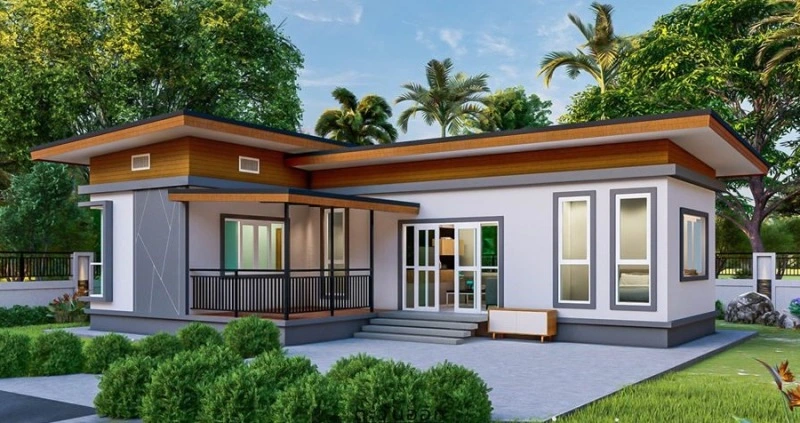If you’re looking for a unique and functional layout for your dream home, then the L shape might be the perfect choice. This architectural design offers many benefits, allowing you to create a space that is visually appealing and highly practical. In this article, we will walk you through what an L-shaped house is, discuss its advantages, and provide tips on designing one effectively.
What is an L-shaped house?
What exactly is an L-shaped house? It’s a type of architectural design where the floor plan resembles the shape of the letter “L.” Instead of a traditional rectangular or square layout, this unique configuration features two wings that meet at a right angle. The more extended wing typically houses the living areas and bedrooms, while the shorter wing can be used for various purposes, such as a garage, office space, or outdoor patio. The beauty of an L-shaped house lies in its versatility. One significant advantage is that it allows for better integration with outdoor spaces. With one side open to a courtyard or garden, you can create a seamless indoor-outdoor flow, connecting your living spaces to nature and maximizing natural light. Another benefit of an L-shaped house is its ability to offer privacy and separation within the interior. You can enjoy added tranquility and quietness by dividing different zones into each wing – such as placing bedrooms in one wing and communal areas in another. This design also facilitates excellent cross-ventilation and natural airflow throughout the home. With windows strategically placed on both wings, you can use cool breezes while minimizing reliance on artificial cooling systems during hot summer. Furthermore, an L-shaped house presents ample opportunities for creating functional outdoor spaces like courtyards or decks between the two wings. These areas provide beautiful relaxing spots or entertain guests outdoors while maintaining privacy from neighboring properties.
The Benefits of an L shaped house
One of the most significant advantages of an L-shaped house is how it maximizes natural light and ventilation. With its unique design, this home style allows for plenty of windows, creating a bright and airy living space. The open layout also encourages airflow throughout the house, making it feel fresh and comfortable. Another benefit of an L-shaped house is its ability to provide privacy and separate different areas within the home. By creating two wings at a right angle to each other, you can easily divide public spaces from private ones or create distinct zones for different activities. This layout is beneficial if you have a large family or frequently entertain guests. An L-shaped house offers excellent opportunities for outdoor living and landscaping. The interior corners created by the shape can be transformed into beautiful courtyards or gardens protected from wind and noise. You can also use these corners to build covered patios or decks to relax and enjoy the surrounding views. An L-shaped house often fits well on irregularly shaped lots or those with limited space. This makes it a versatile choice for various building plots while providing ample room for all your needs. Whether you want spacious bedrooms, a dedicated office space, or even additional storage areas, designing an L-shaped house allows flexibility in accommodating your specific requirements. Designing an L-shaped house brings numerous benefits, such as increased natural light and ventilation, enhanced privacy between sections of your home, opportunities for outdoor living spaces, and flexibility in adapting to different lot sizes and lifestyles. Consider this architectural style when planning your dream home!
How to design an L-shaped house?
This unique architectural style offers many benefits, such as increased privacy, better natural lighting, and the ability to create distinct outdoor spaces. If you’re considering designing an L-shaped house, here are some tips to help you make the most of this innovative layout.
Consider the orientation of your home on your property. The longer side of the “L” should face south or west to maximize sunlight exposure. This will not only provide ample natural light but also reduce energy consumption. Next, consider how you want to utilize each wing of your L-shaped house. You could designate one wing for living areas like the kitchen, dining room, and family room while reserving the other for bedrooms and private spaces.
Another important factor is creating flow between different areas within your L-shaped house. Open-concept designs with large doorways or sliding glass panels can seamlessly connect indoor and outdoor spaces. Consider incorporating a courtyard or patio in the center of your L shape for a tranquil oasis. Take advantage of vertical space by incorporating tall windows that capture scenic views or installing skylights that bring in even more sunshine from above.
Tips for designing an L-shaped house
When designing an L-shaped house, a few key considerations must be remembered. Here are some tips to help you create the perfect layout:
1. Maximize natural light: One of the significant advantages of an L-shaped house is its ability to offer ample natural light throughout the space. Take advantage of this by strategically placing windows and skylights where they will bring in the most sunlight.
2. Create separate zones: With its unique shape, an L-shaped house can designate different areas for specific purposes. Use interior walls or furniture arrangements to create distinct zones such as living areas, dining spaces, and bedrooms.
3. Embrace outdoor living: The open corner created by an L shape can be utilized as an outdoor entertaining area or courtyard. Consider incorporating a patio or deck that seamlessly connects with the interior spaces, allowing for seamless indoor-outdoor living.
4. Optimize privacy: Depending on your location and surroundings, privacy may be a concern when designing your L-shaped house. Carefully plan the placement of windows and consider using landscaping elements or architectural features like screens or fences to ensure privacy where needed.
5. Think about flow: A well-designed home should have good flow between rooms and functional circulation patterns. Pay attention to how people will move through different areas of your L-shaped house and ensure easy access from one space to another.
6. Utilize storage wisely: Storage is vital in any home design project! With limited wall space due to its unique shape, think creatively about incorporating built-in storage solutions that maximize functionality while maintaining aesthetics.
By following these tips when designing your own L-shaped house, you’ll be able to create a home that looks stunning and maximizes functionality and comfort for years to come!





